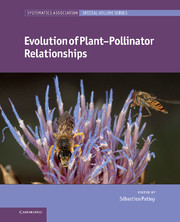Book contents
- Frontmatter
- Contents
- Contributors
- Preface
- 1 Macroevolution for plant reproductive biologists
- 2 Pollination crisis, plant sex systems, and predicting evolutionary trends in attractiveness
- 3 Evolution and ecological implications of “specialized” pollinator rewards
- 4 Fig–fig wasp mutualism: the fall of the strict cospeciation paradigm?
- 5 Fossil bees and their plant associates
- 6 Pollen evidence for the pollination biology of early flowering plants
- 7 Pollinator mediated floral divergence in the absence of pollinator shifts
- 8 Animal pollination and speciation in plants: general mechanisms and examples from the orchids
- 9 Why are floral signals complex? An outline of functional hypotheses
- 10 A survey on pollination modes in cacti and a potential key innovation
- 11 Zygomorphy, area, and the latitudinal biodiversity gradient in angiosperms
- 12 Ambophily and “super generalism” in Ceratonia siliqua (Fabaceae) pollination
- 13 Structure and dynamics of pollination networks: the past, present, and future
- 14 Pollinators as drivers of plant distribution and assemblage into communities
- 15 Effects of alien species on plant–pollinator interactions: how can native plants adapt to changing pollination regimes?
- 16 Pollen resources of non-Apis bees in southern Africa
- 17 Advances in the study of the evolution of plant–pollinator relationships
- Index
- Plate section
- References
Preface
Published online by Cambridge University Press: 05 January 2012
- Frontmatter
- Contents
- Contributors
- Preface
- 1 Macroevolution for plant reproductive biologists
- 2 Pollination crisis, plant sex systems, and predicting evolutionary trends in attractiveness
- 3 Evolution and ecological implications of “specialized” pollinator rewards
- 4 Fig–fig wasp mutualism: the fall of the strict cospeciation paradigm?
- 5 Fossil bees and their plant associates
- 6 Pollen evidence for the pollination biology of early flowering plants
- 7 Pollinator mediated floral divergence in the absence of pollinator shifts
- 8 Animal pollination and speciation in plants: general mechanisms and examples from the orchids
- 9 Why are floral signals complex? An outline of functional hypotheses
- 10 A survey on pollination modes in cacti and a potential key innovation
- 11 Zygomorphy, area, and the latitudinal biodiversity gradient in angiosperms
- 12 Ambophily and “super generalism” in Ceratonia siliqua (Fabaceae) pollination
- 13 Structure and dynamics of pollination networks: the past, present, and future
- 14 Pollinators as drivers of plant distribution and assemblage into communities
- 15 Effects of alien species on plant–pollinator interactions: how can native plants adapt to changing pollination regimes?
- 16 Pollen resources of non-Apis bees in southern Africa
- 17 Advances in the study of the evolution of plant–pollinator relationships
- Index
- Plate section
- References
Summary
Preface
Pollination has been a source of questioning and fascination as long as there have been naturalists. Aristotle and Herodotus before him were already according a specific interest to the topics of fig and palm pollination. In the eighteenth and nineteenth centuries – adopting a more adaptationist point of view – Kölreuter (1761), Sprengel (1793), and Darwin (1862) authored books that constitute the early stepping stones in development of modern pollination biology. From the time Darwin published the On the Origin of Species (1859), the functional relationships of plant and pollinator were cast in evolutionary scenarios in which plants adapted to pollinators and pollinators adapted to flowers.
Over the last decade, many edited volumes have been published on pollination-related topics (Proctor et al. 1997; Chittka and Thomson 2001; Dafni et al. 2005; Waser and Ollerton 2006; Harder and Barrett 2007). The present volume originated in a symposium dedicated to the evolution of plant–pollinators relationships (EPPR), which was organized in the framework of the SYSTEMATICS 2009 meeting in Leiden in the Netherlands. Given the intense scientific activity in pollination biology (Mitchell et al. 2009), the idea behind this symposium was to provide a forum for authors to pull together recent advances in pollination in the context of systematics. The present book constitutes an outcome of this symposium along with its natural prolongation. It has been developed with an explicit sensitivity for the evolutionary aspects of pollination. It includes contributions from the participants in the symposium and additional authors who joined the book project to round out its evolutionary coverage.
- Type
- Chapter
- Information
- Evolution of Plant-Pollinator Relationships , pp. xi - xviPublisher: Cambridge University PressPrint publication year: 2011



